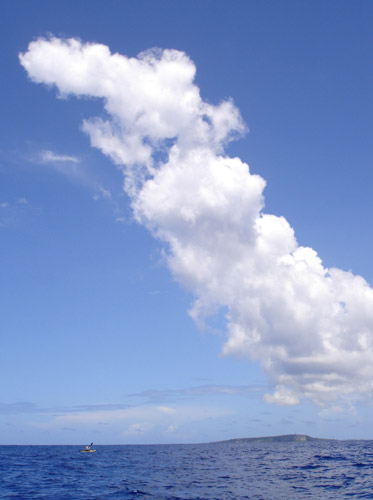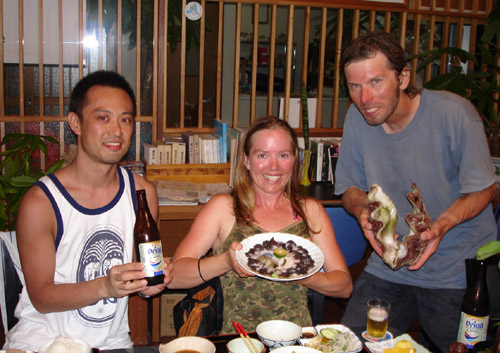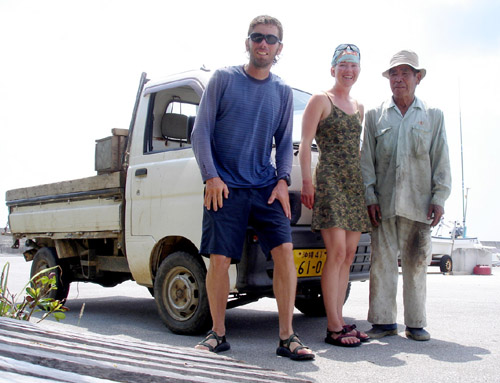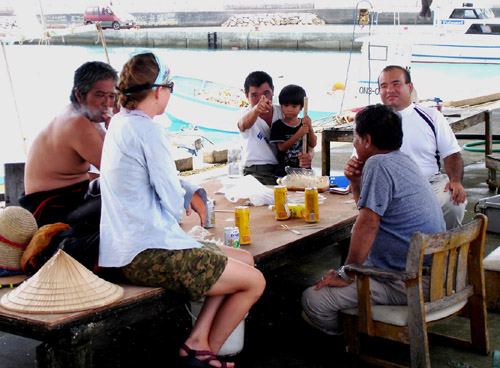Okinawa Kayak trip, Summer 2006, Part4

Okinawa Kayak trip map.
On our way from Kume Island to Aguni island we almost right away met the expected westerly current that was to slow us for the first 10km or so. Fighting the current directly is wasteful, so we set a more northerly course than required and let ourselves drift, hopefully making up for our lost direction with our increased speed. Nevertheless an early loss of morale descended on us due to the slow progress; this combined with a calm sea and a bright, hot early morning sun to induce in me an immense sleepiness. In a kayak it’s similar to (though definitely less dangerous than) driving a car when you’re sleepy: you flounder into semi-consciousness, to be snapped into action with a start – this time it’s a only quick brace to avoid plopping face-first into the water. It got so bad that soon I had no choice but to “pull over”, trying to nap while crammed most uncomfortably into the kayak. Twenty minutes later, I had already drifted a kilometer westward and Leanne was just a tiny speck on the horizon. An hour later when I caught up to her, I was sleepy again! I announced a revised course, and seeing Leanne follow it faithfully I dozed off again. Later the current had gradually veered and weakened, allowing us to compensate more favorably, and for a while things went quickly. Then within what we thought would be an hour west of Aguni’s prominent Cape Fudan, a new counter-current began. It was difficult to say whether this was due to the change in the tide, or a phenomenon caused by the island itself; in any case it cut our speed in half. We fought on valiantly as the cliffy cape grew ever so slowly before us. Over two hours later, we were finally past it in stationary water. It took another 45 minutes to go to the port, 3km distant (we were tired!). Leanne looked overheated so we hosed ourselves down repeatedly, drank cold Cokes and can coffees from the jidohanbaiki and sat in the breeze while our temperatures returned to normal, at first almost shivering though it was 35C.
Next day the heralded northerly breeze began. We considered our tired condition, the headwind and the fickle, unpredictable currents. To do the 55km traverse to Ie-jima, the longest of our trip, would be imprudent today. So we recuperated and wandered about, talking with the friendly locals and numerous holiday divers from Japan’s large cities. Due to the clarity of its sea and its isolated position, Aguni is one of Japan’s most famous diving destinations, where one can swim about among schools of tuna and other large fish. The divers, like most holidaymaking Japanese, have very limited time (say, 3 days) to enjoy their vacations so they do not mind paying something like $100 per dive, definitely enriching the local economy. Ironically, our time and energy were even more limited and for the sake of rest we did not paddle to the cape and snorkel among the tuna (for free).

However we did hook up with some visiting snorkelers for a shell hunt around the reef just outside the harbor. With their cooperation and crowbar, I was able to wrench a huge clam from the deeper part of the reef and our floating basket quickly filled with other clams and fist-size snails. All this was devoured with dinner at the snorkelers’ inn, mostly in the raw state, as locals prefer. The giant clam had an unexpected taste, not at all unpleasant, but I felt a bit unworthy eating it as a delicacy and not having left it in the reef where it had been growing for so many years.
Returning to the port at night, we saw the divers engaged in a lively drinking party at the picnic tables. We said good-by as we would be leaving for Ie-jima before dawn.
By this point we had given up predicting the currents; the information gleaned from the Japan Coast Guard website seemed all wrong and though I’d made careful measurements every few kilometers on all crossings (utilizing the GPS and a Coke bottle filled with seawater), this information remained too scant to extrapolate from. On the west side of tiny Aguni Island the current is least at low tide, so we selected our departure thusly. Yet on the island’s east side, where we now found ourselves, the current was still full strength. Another epic traverse had begun. We made truly pathetic progress until about noon; we tried not to keep glancing back to see how close Aguni still appeared. Then the current vanished, and we made good headway into the late afternoon. Though no land had been visible most of the time, the hitherto unusual sight of bits of garbage in the water told us we that were approaching the populated coast of Okinawa. Ie-jima, quite flat except for a single, landmark, pimple-like mountain (locally called Tatchuu) had become visible when 20km distant; at about the same time a weak current once more set against us. The sun had sunk quickly into the sea and now the lights of Ie-jima belied the scale of the seascape. It seemed to take a long time as the waves, wind and current slowly diminished in the island’s shadow; at 11pm we were finally between the lights marking either side of the artificial opening in the reef and the entrance to a fishing port. It had taken us 19 hours to paddle here from Aguni; due to the currents we were obliged to lengthen the 55km direct course to a more sinuous 61km. Obviously exhausted, we were lured now more by sleep than by hunger. But we struggled to stay awake a little more to cook and devour a quick pasta dinner. Without food we might wake up useless the next morning, but we could not afford another rest day at this point.
The sun woke us up with its heat not long after it rose. The port, however, had a large roofed area with – sofas! As we relished in the decadent comfort of these household rejects, we realized it had been a really long time since our previous sofa experience – in Japan one usually sits on the ground, more or less. Certainly a number of families on Ie-jima were bucking tradition. Waiting out the noonday heat we lounged on, planning to set out in the afternoon for Izena, 34km to the northeast. In the meanwhile we were noticed by the locals: first an elderly gentleman who, unprompted, raced off in his mini-truck, returning with what he thought island-hopping foreigners might enjoy eating: convenience store cheese-burgers, fried chicken, sandwiches, a frozen 2 liter bottle of “Pocari Sweat” (imitation Gatorade), and just in case, two Japanese ‘bento’ box lunches. He figured we’d be hungry, and hungry we were.

The good will of friendly island folk like this gentleman who brought us a three-course convenience store lunch, cannot be denied.
Later, very stuffed, we napped contentedly on the sofas, but soon a motley group of fishermen invited us to their corner, all sharing a lunch consisting of chunks of raw fish and clams mixed wholesale with soy sauce in a ripped-open plastic water bottle. Conversation was lively and animated and one particular character, referred to by everyone as ‘sencho’ (the Captain) commanded a lot of respect and attention. He had just returned from spearing fish with an abundant catch of choice species, his full-body wetsuit now unzipped dangerously low under his protruding naked belly. He showed not a smidgeon of embarrassment when a group of obviously influential local ladies suddenly showed up to spread some civic message, and displayed only a mild satisfaction when one of them bought the choice of his catch on the spot for a very reasonable day’s wages. When we told him about our travels, he said to us, “Antatachi wa purimun da”, using a dialect word that, loosely translated, spans the spectrum of somewhere between ‘stupid’ and ‘idiot’. “I tell you this, because when you’re ‘purimun’, you won’t notice it yourself”, he added helpfully, as the others chuckled. When Leanne pointed to the air compressor on his boat and said that he might be the purimun, diving to 40 meters with an air hose in his mouth, he retorted, “Yeah, but I have a kid in university I have to pay for. You do this nonsense on your free time!” Talking with the Captain was a blast and too soon, it was time to go. Everyone waved enthusiastically as we paddled out around the port breakwater.

The Captain lights up after a hearty lunch of raw fish, soy sauce, and Okinawa’s own Orion beer.


0 Comments:
Post a Comment
<< Home